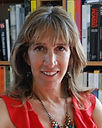FROM MY WINDOW
By Mercedes Moresco
December today
I've noticed that lately December starts in November. Faster and faster. I can't even gather the pumpkins and skeletons for Halloween before some neighbors put inflatable reindeer out to graze in their yards. Here, December doesn't just arrive; it knocks on the door and walks right through.
When I lived in Argentina, December began on the 8th, the Day of the Virgin, when we put up the tree and decorated it with multicolored ornaments. Here it's different. If I wait until the 8th, I probably won't find anything in the stores but the leftover decorations that nobody wants. By then, you can't find anything. That's why, as an immigrant, I've adapted to this general anxiety, and although I try to wait until the end of the month, you can almost certainly see the tree in my house by December 1st. Besides, I recognize that it's a good idea to take advantage of this long Thanksgiving weekend and decorate with Christmas spirit.
This last part has become more complicated over the years. When the boys were little, they loved helping me at Christmas, hanging up decorations, writing letters to Santa. But my children grew up. If it were up to my husband, there wouldn't be a tree or stars in the house, let alone lights hanging from the ceiling or trees.
So I'm the one who climbs the ladder, tries to even out the decorations, and despite my lack of skill at decorating, I try to give my house a Christmas feel. Because I love it. I love December and the cooler weather, the carols, the general joy. I'm one of those people. Yes.
My family, though not very helpful, enjoys the spectacle. Sometimes Luz, the youngest, makes time out of her youth to help me, but I usually put it up and take it down myself. And while I'm doing it, I think about how a year has passed, then another, how many things I didn't do and how many I did, how I didn't finish this or start that. And then come the slips of paper with wishes: next year I'm going to, I want this, I want that, and so the tree fills up with promises and dreams.
December is a demanding month. It demands reflection. And for many, it's a thorn in their side, something annoying that's best left over quickly, something to jump over like a barbed-wire fence, trying not to get pricked. For my part, my Piscean nature, or perhaps my coming of age, prevents me from remembering exactly what I set out to do at the beginning of this year. Maybe because I don't take resolutions that seriously, maybe because I've learned that although one proposes, God disposes, so it's more about doing what one can with what fate has dealt.
I leave with my readers all my December joy, this kind of naiveté that floods me at this time of year, a bit like going back to being that little girl who hung the star on top of the tree, and maybe I'll infect you with it too.
Happy holidays to all, and may January, a much kinder and more productive month than December, find you with renewed energy.
Mercedes Soledad Moresco, Writer
Follow me on Instagram @mermoresco







.jpg)